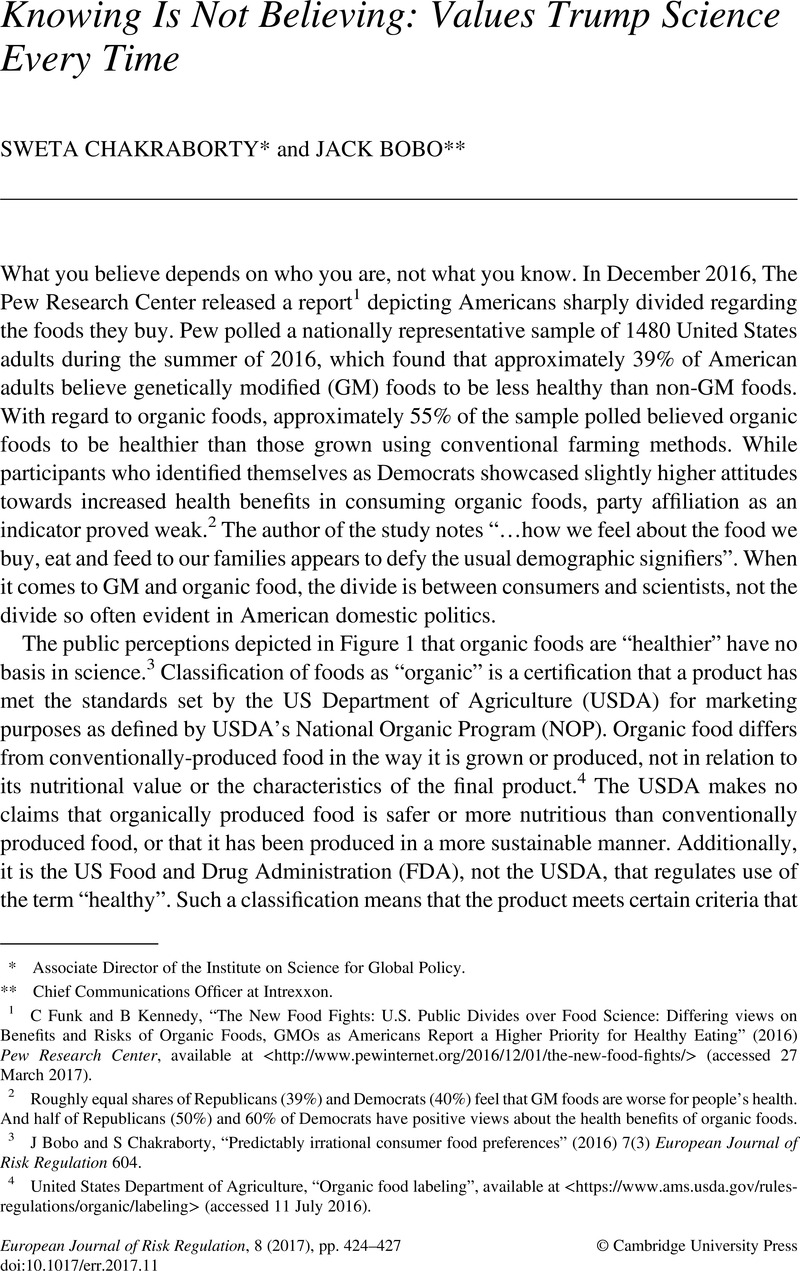No CrossRef data available.
Article contents
Knowing Is Not Believing: Values Trump Science Every Time
Published online by Cambridge University Press: 21 July 2017
Abstract

- Type
- Reports
- Information
- Copyright
- © Cambridge University Press
Footnotes
Associate Director of the Institute on Science for Global Policy.
Chief Communications Officer at Intrexxon.
References
1 Funk, C and Kennedy, B, “The New Food Fights: U.S. Public Divides over Food Science: Differing views on Benefits and Risks of Organic Foods, GMOs as Americans Report a Higher Priority for Healthy Eating” (2016) Pew Research Center, available at <http://www.pewinternet.org/2016/12/01/the-new-food-fights/> (accessed 27 March 2017)Google Scholar.
2 Roughly equal shares of Republicans (39%) and Democrats (40%) feel that GM foods are worse for people’s health. And half of Republicans (50%) and 60% of Democrats have positive views about the health benefits of organic foods.
3 J Bobo and S Chakraborty, “Predictably irrational consumer food preferences” (2016) 7(3) European Journal of Risk Regulation 604.
4 United States Department of Agriculture, “Organic food labeling”, available at <https://www.ams.usda.gov/rules-regulations/organic/labeling> (accessed 11 July 2016).
5 The term “healthy” and related terms (“health”, “healthful”, “healthfully”, “healthfulness”, “healthier”, “healthiest”, “healthily” and “healthiness”) may be used if the food meets the following requirements available at <http://www.fda.gov/Food/GuidanceRegulation/GuidanceDocumentsRegulatoryInformation/LabelingNutrition/ucm064916.htm>.
6 National Academy of Sciences, Engineering, and Medicine, “Genetically Engineered Crops: Experiences and Prospects” (National Academies Press 2016), available at <https://www.nap.edu/catalog/23395/genetically-engineered-crops-experiences-and-prospects>>Google Scholar.
7 Funk and Kennedy, supra note 1.
8 Funk, C and Rainie, L, “Public and Scientists’ Views on Science and Society” (Pew Research Center 2015), available at <http://www.pewinternet.org/2015/01/29/chapter-3-attitudes-and-beliefs-on-science-and-technology-topics/> (accessed 27 March 2017)+(accessed+27+March+2017)>Google Scholar.
9 Kahneman, D and Tversky, A, “Prospect Theory: An Analysis of Decision under Risk” (1979) 47(2) Econometrica 263 CrossRefGoogle Scholar.
10 Festinger, L, A Theory of Cognitive Dissonance (Row, Peterson 1957)Google Scholar.
11 Nickerson, R, “Confirmation Bias: A Ubiquitous Phenomenon in Many Guises” (1998) 2(2) Review of General Psychology 175 CrossRefGoogle Scholar.
12 Mercier, H and Sperber, D, The Enigma of Reason (Harvard University Press 2017)Google Scholar.
13 Kahan, D, “Ordinary Science Intelligence: A Science-Comprehension Measure for Study of Risk and Science Communication, with Notes on Evolution and Climate Change” (2014) Journal of Risk Research Yale Law & Economics Research Paper No. 504; The Cultural Cognition Project Working Paper No. 112, available at <https://ssrn.com/abstract=2466715> or <http://dx.doi.org/10.2139/ssrn.2466715> (accessed 27 March 2017)Google Scholar.
14 Sloman, S and Fernbach, P, The Knowledge Illusion: Why We Never Think Alone (Riverhead Publishing 2014)Google Scholar.
15 Chakraborty, S, “Risk and Crisis Communication Recommendations for Industry Based on Advances in Cognitive Behavioral Science Research” (2014) 2 European Journal of Risk Regulation 238 CrossRefGoogle Scholar.




